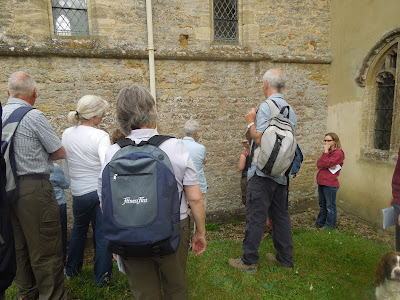
At the edge of the village Lesley pointed out the changes in level visible in the view across to Wytham Woods. The variations in the landscape, resulting from the action of the River Thames, are hard to see until pointed out by an expert and as Kathryn emailed me after the walk .....'It gives us so much more of
a sense of history when, for example, we drive up the hill at Linch Hill and
are now aware that it is the division between one gravel terrace and another,
formed by the Thames over thousands of years'.
Walking round the edge of the landfill site along the public footpath to Linch Hill we passed an area of grassland that now has a wealth of wildflowers including common knapweed and ladies bedstraw. This little known footpath then runs alongside an area of dense and scrubby woodland that has grown up naturally in the quarry bottom making an interesting contrast to the newly planted woodland further along by Dix Pit lake.
We then walked alongside Dix Pit which is a huge lake that is now a County wildlife site for birds; gulls and ducks in particular. During the gravel extraction operations much evidence was gathered about previous climatic conditions and palaeochannels from around 200,000 years ago. The excavations revealed over 1000 mammoth remains-tusks, teeth and bones as well as the remains of forest elephant, bison, lion and bear and insects, snails and fresh water molluscs. Twenty six stone tools were also found.
When we got to the Devil's Quoits I was surprised at how many of the group had never visited them before. This henge monument, originally built 4900-4600 years ago, was restored between 2002 and 2008 as a result of the quarrying restoration agreement.
If photographed from a certain angle you would have no idea that this stone circle is right next to a massive landfill site.
By the end of the 19th century there were only three stones left standing but six others were found nearby and nineteen new ones were supplied from the current gravel extraction site at Gill Mill. These new ones are from a very similar strata of conglomerate but they are weathering away much faster than the stones that have been on site for thousands of years. They were formed in slightly different climatic conditions so the cementing sand is less resistant to weathering.
One of the original stones weathering slowly with quite a smooth surface.
This walk will be followed by other walks and talks about a range of topics to do with the environment, wildlife and local history in the Lower Windrush Valley. If you would like to have early notification of future events please email me at jane.bowley@oxfordshire.gov.uk.



No comments:
Post a Comment